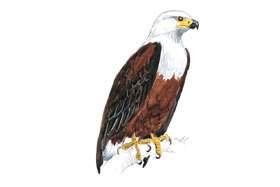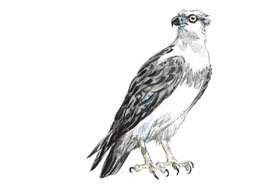
African Fish-Eagle (Haliaeetus vocifer)
Afrikaans: Visarend
One of Africa's most romanticised birds is the African Fish-Eagle, which is not in danger from extinction as much as from brand degradation by advertising agencies. Its distinctive, echoing call is a common sound in the riverine forests where it nests.
It is most active on windy days and flies less when the weather is calm. It is mostly seen in pairs that are highly territorial, staking out their own piece of river frontage with rivals' nests being at least eight kilometres apart.
The African Fish-Eagle usually hunts from a tall tree overlooking an open watercourse. It can perch for long periods of time before swooping down dramatically on surface-feeding freshwater fish - mostly tilapia and catfish. It feeds also on carrion, small mammals and birds, especially waterbirds and game fowl, as well as the eggs of plovers and other waders.
It is an aggressive hunter, known to seize a crocodile hatchling, rob a snake from a Bateleur's talons and take out fish from a Pelican's beak. It regularly harasses other waterbirds to disgorge their prey, which it then pirates. When it gets its food it either returns to the perch or settles on a sandbank to feed.
Although the African Fish-Eagle is a common sighting because it is found on all the major rivers, there are actually surprisingly few birds - Roberts VII estimates a breeding population of just 128 in the Park.
African Fish Eagle Characteristics
Adult Height
63-73cm
Weight
2-3kg
Wingspan
1.9m
White head and breast; chestnut underparts and forewings; distinctive, ringing cry.Resident
Prey
Predominantly fish diet - favours fish with average weight of 1.5kg.
Where best to find them
Along most of Kruger's dams and rivers, particularly the Crocodile, Sabie, Letaba, Olifants and Luvuvhu Rivers.
Osprey (Pandion haliaetus)
Afrikaans: Visvalk
The Osprey looks like a raptor and flies like a gull. It is not often seen in the inland areas of the subcontinent and there is uncertainty as to whether it is a local breeder, a migrant or both. Roberts VII estimates the entire southern African population to number fewer than 500 birds.
Only occasionally seen in Kruger, the Osprey is a bird of solitary habits that circles open bodies of water searching for its main food - fish. It then swoops down, often completely submerging itself, to catch its prey. It does not interact aggressively with other raptors except for the African Fish-Eagle, which is its main competitor in the food chain. It is generally a silent bird.
Osprey Characteristics
Adult Height
59cm
Weight
1.4-1.7kg
Wingspan
1.45-1.7m
Looks like a large aggressive gull; yellow eye and dark band through the eye are identifying characteristics.Migrant
Prey
Fish weighing around 500g, but lots of tilapia as well - it is capable of diving a metre underwater to catch fish. Biggest recorded prey is a 3-kg fish.
Where best to find them
More common on the Mozambican side of the Transfrontier Park at Massingir Dam; sometimes seen on the larger dams along the main rivers; also sightings at Lake Panic near Skukuza and around Lower Sabie.



